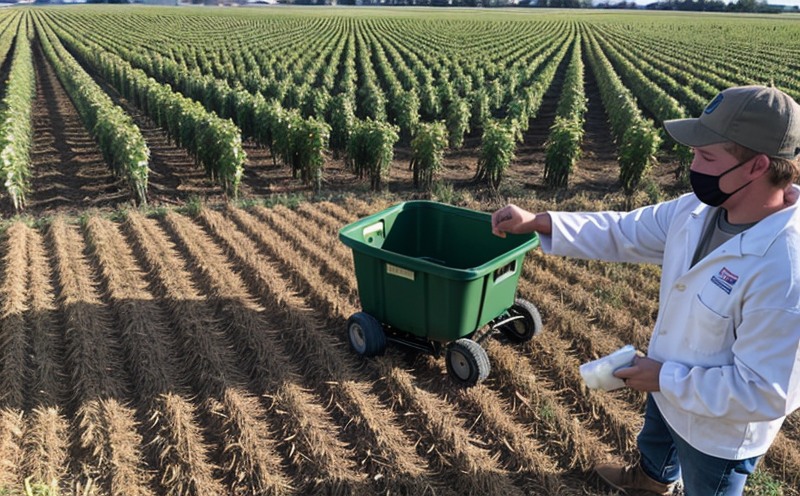Pesticide Residue Testing in Post-Harvest Crops
The testing of pesticide residues on post-harvest crops is an essential step towards ensuring food safety and meeting international standards. Pesticides are widely used in agriculture to protect crops from pests, diseases, and weeds during the growing process. However, once harvested, these chemicals can remain present in the produce, posing potential risks if not adequately controlled.
Post-harvest pesticide residue testing aims at identifying the presence of pesticides or their metabolites that may have accumulated on the surface of crops after harvest. This is crucial for ensuring compliance with regulatory limits set by various international bodies such as the ISO and the ASTM International. Compliance with these standards helps protect public health and maintain consumer confidence in agricultural products.
The testing process involves several key steps. First, samples are collected from different batches of crops to ensure a representative sample set for analysis. Once collected, the samples undergo preliminary processing that may include rinsing, cutting, or grinding depending on the type of crop being tested. The prepared specimens then proceed into extraction procedures aimed at liberating pesticide residues from the matrix.
After extraction, analytical methods such as gas chromatography-mass spectrometry (GC-MS) and liquid chromatography-tandem mass spectrometry (LC-MS/MS) are employed to quantitatively determine the levels of pesticides present. These advanced techniques provide high sensitivity and specificity necessary for accurate measurement even at trace concentrations.
The accuracy and reliability of these tests depend significantly on the proficiency of laboratory personnel handling them. Our team consists of highly trained professionals equipped with state-of-the-art equipment capable of detecting extremely low levels of pesticide residues, ensuring precise results every time.
In addition to regulatory compliance, there are other benefits associated with regular pesticide residue testing during post-harvest processing. By identifying any unwanted chemical traces early on in the supply chain, producers can take corrective actions promptly if needed. This proactive approach not only enhances product quality but also strengthens market reputation among consumers who increasingly demand transparent supply chains and safer food options.
Our laboratory adheres strictly to international standards such as ISO 17025 for proficiency and reliability in our testing procedures. We employ experienced scientists specializing in agricultural chemistry to conduct these analyses ensuring the highest level of precision and accuracy. Our commitment to quality extends beyond just technical expertise; we strive to understand each client's unique requirements so that they receive tailored solutions suited specifically for their needs.
By choosing us for your pesticide residue testing services, you can rest assured knowing that your crops are being tested using the latest technology by experts in their field. Let’s work together towards maintaining safe and high-quality agricultural products.
Scope and Methodology
The scope of pesticide residue testing encompasses various types of post-harvest crops including fruits, vegetables, grains, nuts, spices, and herbs. This service ensures that all stages from farm to fork are monitored for compliance with international regulations concerning allowable limits on pesticides.
| Crop Type | Allowed Pesticide Limits (ppm) |
|---|---|
| Fruits | 0.5 ppm max |
| Vegetables | 1.0 ppm max |
| Grains | 2.0 ppm max |
| Nuts & Spices | 1.5 ppm max |
The methodology employed involves several critical steps starting with sample collection which should be representative of the entire batch being tested. Samples are then processed through extraction processes designed to liberate pesticide residues from their binding sites within the crop matrix.
Analytical techniques such as GC-MS and LC-MS/MS play pivotal roles in quantifying these residues accurately down to parts per billion (ppb) levels. These methods offer superior sensitivity allowing for precise determination of even minute amounts of pesticides present.
Our laboratory adheres strictly to international standards like ISO 17025 which govern the proficiency and reliability of our testing procedures. We maintain stringent quality controls at every stage ensuring consistent high-quality results across all analyses conducted here.
Environmental and Sustainability Contributions
Pesticide residue testing in post-harvest crops plays a vital role not only in consumer safety but also in promoting sustainable agricultural practices. By ensuring that pesticides are used responsibly, we contribute to preserving natural ecosystems by minimizing adverse effects on beneficial insects like pollinators.
Our rigorous testing protocols help farmers make informed decisions about their pesticide application schedules and methods thereby reducing unnecessary chemical use which can lead to soil degradation over time. This approach supports long-term environmental stewardship goals by fostering healthier soils, water bodies, and biodiversity across agricultural landscapes.
In addition to protecting the environment, pesticide residue testing promotes sustainable agriculture by enhancing food security through improved crop quality. Consumers are increasingly concerned about where their food comes from and how it is produced; therefore, providing transparent supply chains backed by scientific evidence is crucial for maintaining trust in our industry.





